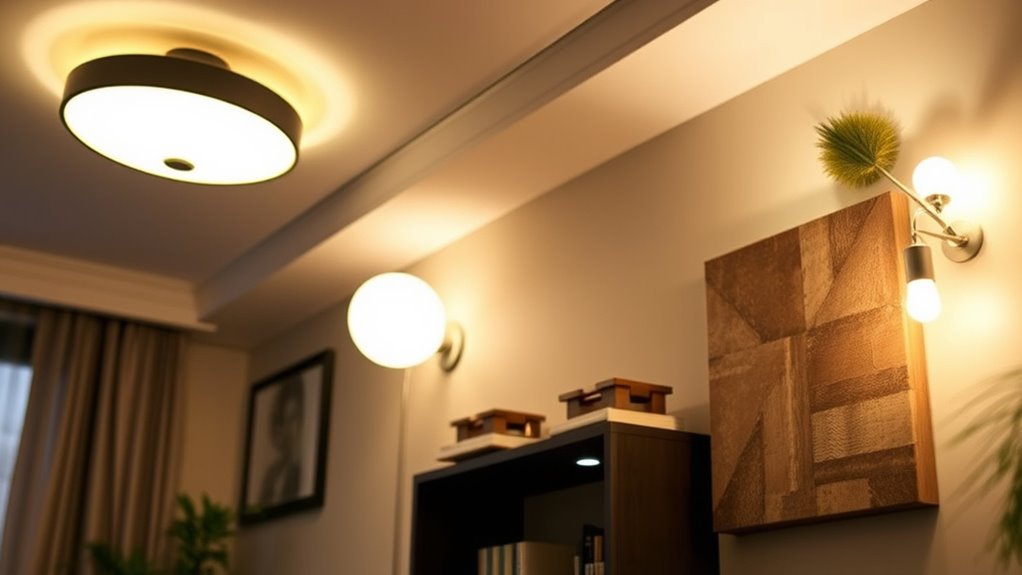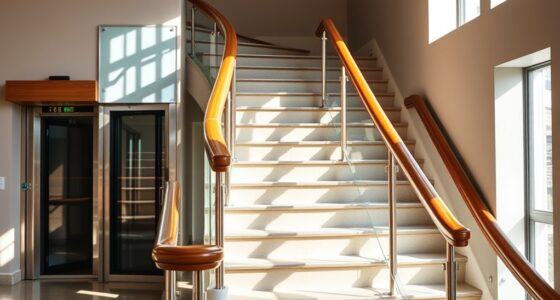To improve lighting for low vision, focus on layering different types of light—ambient, task, and accent—to boost visibility and reduce shadows. Use glare-reducing fixtures, indirect lighting, and dimmers to create a comfortable environment that highlights contrast and minimizes reflections. Adjust lighting based on space use, and choose warmer or cooler tones strategically. Continuing with these tips will help you create a safer, more visually accessible setting tailored to your needs.
Key Takeaways
- Implement layered lighting combining ambient, task, and accent lights to improve overall visibility and reduce shadows.
- Use indirect lighting, diffusers, and matte finishes to minimize glare and enhance comfort for low vision individuals.
- Adjust light levels with dimmers and smart controls to maintain appropriate brightness and prevent overpowering light.
- Increase contrast by selecting dark and light colors and strategic lighting placement to make objects easier to distinguish.
- Tailor lighting layers to each space’s purpose, ensuring flexibility and optimal glare control for safe navigation.
Understanding the Importance of Layered Lighting
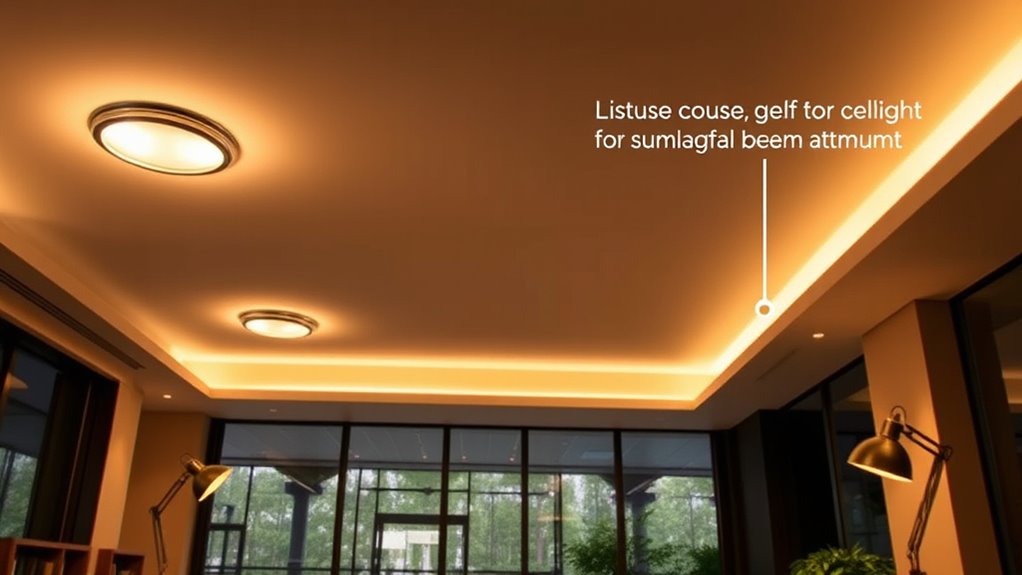
Layered lighting is essential for enhancing visibility and safety for individuals with low vision. It creates an ambient ambiance that reduces shadows and harsh glare, making spaces more comfortable and navigable. By combining different lighting layers, you can control how light interacts with your environment, emphasizing important features and improving overall clarity. Color contrast plays a crucial role in layered lighting, helping you distinguish objects and surfaces more easily. Properly layered lighting reduces visual confusion and fatigue, enabling you to see details more clearly and move confidently through your space. When thoughtfully designed, this approach offers a balanced, well-lit environment that supports low vision needs without overwhelming your senses. Additionally, understanding how cybersecurity vulnerabilities can affect digital environments highlights the importance of secure and reliable lighting controls in smart home systems.
Types of Lighting for Enhanced Visibility
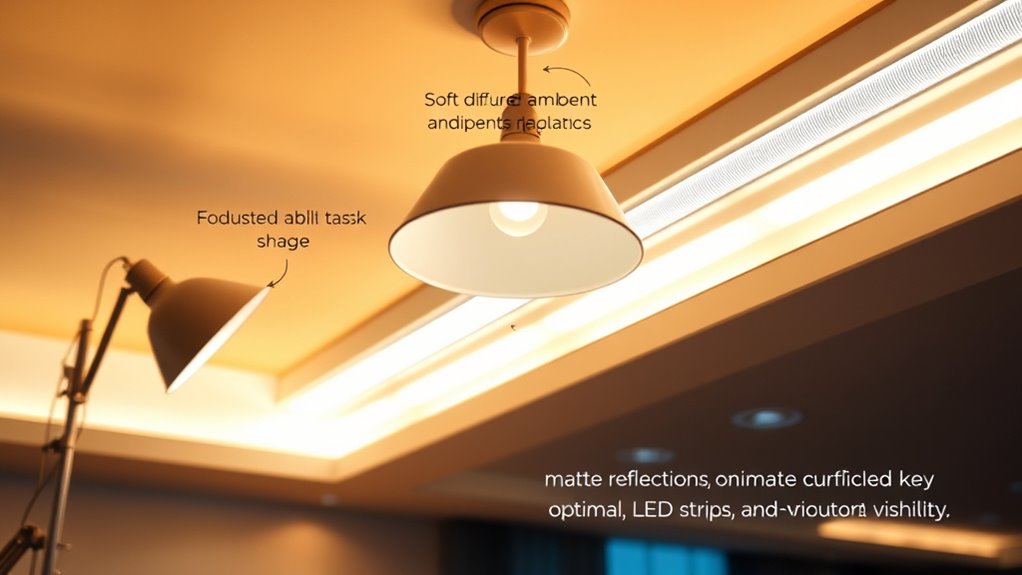
Different types of lighting serve specific functions in creating an environment that enhances visibility for people with low vision. Bright, direct lighting helps increase overall illumination, reducing shadows and making objects easier to see. To improve clarity, focus on high color contrast—using dark and light colors together—so objects stand out clearly. The color temperature of your lights also matters; cooler temperatures (around 4000K) produce a crisp, white light that enhances detail, while warmer tones (around 2700K) create a softer ambiance. Combining task lighting with ambient sources allows you to tailor lighting to different activities, reducing glare and shadows. Choosing the right type of lighting based on color contrast and color temperature helps you create a space that’s visually accessible and safe. Incorporating lighting for low vision principles, such as minimizing glare and ensuring consistent illumination, further enhances visibility and safety.
Techniques for Effective Layering in Different Spaces
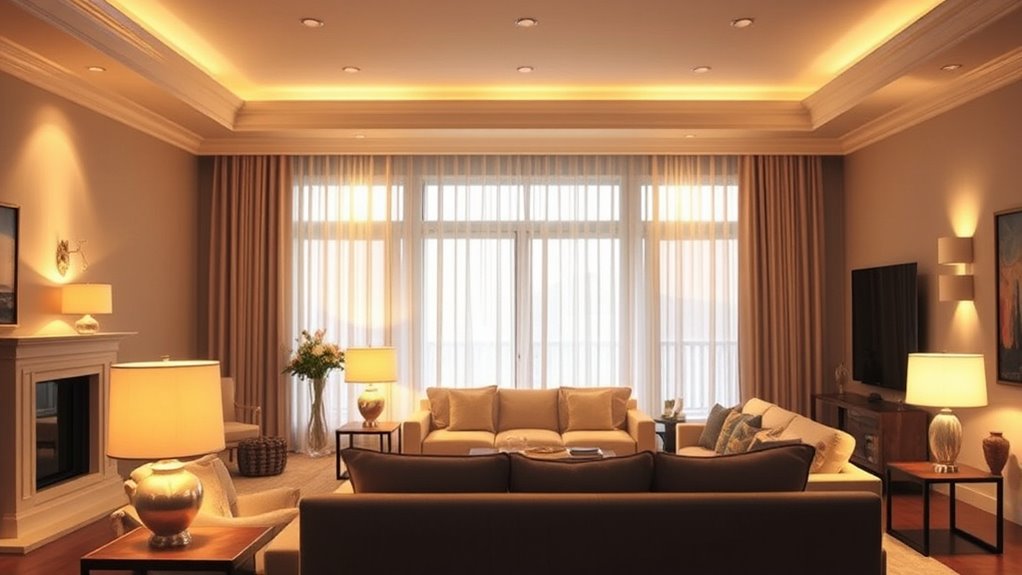
To create effective lighting for low vision, you need to combine multiple lighting sources that work together seamlessly. Layering involves using ambient illumination to provide overall brightness, complemented by task lighting for specific activities. In different spaces, adjust lighting to enhance color contrast, making objects and surfaces stand out clearly. Use warmer or cooler tones strategically to improve visibility and reduce confusion. For example, in a kitchen, bright overhead lights combined with focused under-cabinet lighting create depth and clarity. In living areas, soft ambient light prevents harsh shadows while highlighting key features. Proper layering ensures your environment is well-lit without overwhelming glare, making navigation and tasks easier. Additionally, incorporating layered lighting techniques can significantly improve visual comfort and spatial perception. Consistently tailor your lighting layers to suit each space’s purpose and your specific vision needs.
Strategies for Glare Reduction and Management
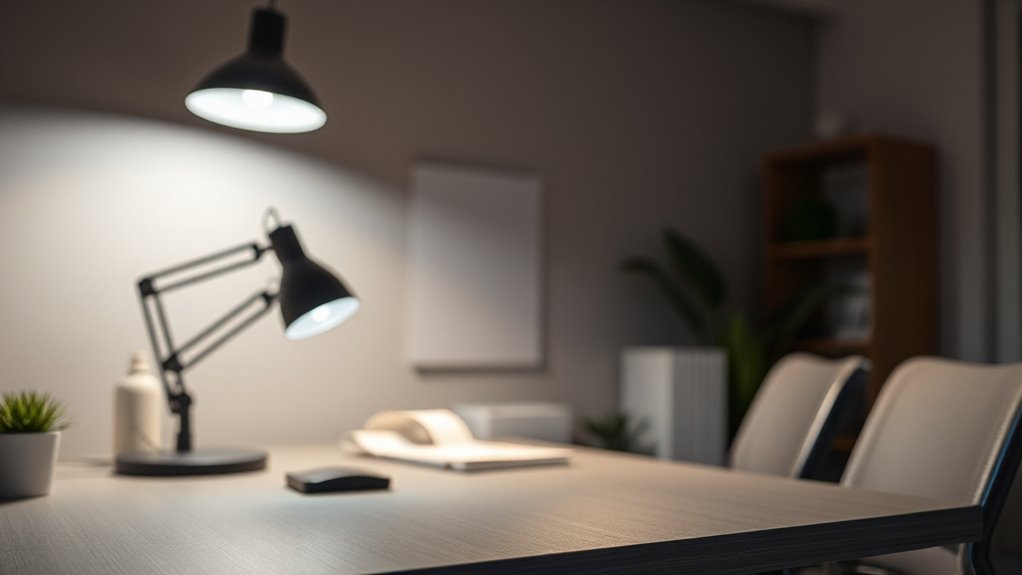
Glare can considerably hinder visibility for those with low vision, making it essential to implement effective strategies to reduce and manage it. Proper glare reduction improves comfort and enhances visual clarity. Use indirect lighting whenever possible, avoiding direct light sources that cause harsh reflections. Adjust light levels with dimmers to prevent overpowering brightness. Consider the placement of fixtures to minimize light spill into your eyes. Incorporate the following light management strategies:
| Strategy | Benefit |
|---|---|
| Use matte finishes | Reduce reflections and diffuse light evenly |
| Install blinds/shades | Control incoming light and glare from windows |
| Employ diffusers | Soften light and prevent sharp glare sources |
These techniques help you maintain better control of glare, creating a safer, more comfortable environment for low vision needs. Additionally, understanding AI-driven lighting solutions can further optimize glare management through smart automation.
Practical Tips for Implementing Optimal Lighting Solutions
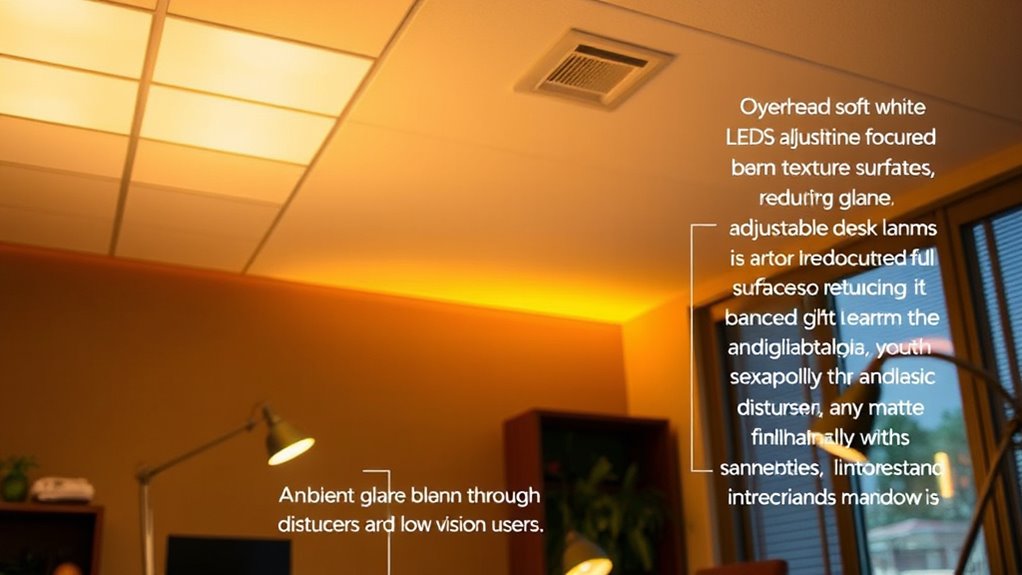
Implementing ideal lighting solutions begins with evaluating your environment to identify areas needing better illumination and glare control. Use adaptive fixtures that can be adjusted for brightness and direction, ensuring tailored lighting for different tasks. Position lights to minimize glare, avoiding direct reflections into your eyes. Incorporate lighting that enhances color contrast, making objects and text stand out clearly. Focus on layering light sources—combine ambient, task, and accent lighting—to create a balanced environment. Consider using fixtures with adjustable arms or dimming options for flexibility. Regularly assess your space, making adjustments as needed to optimize visibility and comfort. By thoughtfully selecting adaptive fixtures and emphasizing strong color contrast, you’ll create a safer, more functional environment suited for low vision needs.
Frequently Asked Questions
How Does Color Temperature Affect Low Vision Lighting?
Color temperature impacts low vision lighting by influencing color warmth, which affects your visual comfort. Cooler temperatures (higher Kelvin) provide a bluish light that enhances contrast but may cause glare, while warmer temperatures (lower Kelvin) offer a softer, more comfortable glow that reduces glare and eye strain. You should choose a balanced color temperature that improves visibility without sacrificing comfort, making it easier for you to see clearly and work safely.
Can Smart Lighting Systems Improve Visibility for Low Vision Users?
Smart lighting systems act like a helpful guide, adjusting brightness and glare to improve your visibility. With adaptive controls, you can customize lighting based on your needs, making tasks easier and safer. Plus, they boost energy efficiency by dimming or turning off lights when not needed. These features create a brighter, more comfortable environment tailored to your low vision needs, making everyday activities clearer and less stressful.
What Are the Best Materials for Glare-Resistant Light Diffusers?
You should look for glare-resistant light diffusers made from matte finishes or frosted films. These materials scatter light evenly, reducing harsh glare and improving visibility. Matte finishes on fixtures or frosted films on covers soften the light and prevent reflections that can cause discomfort. By choosing these materials, you create a more comfortable environment, making it easier for low vision users to see clearly without distraction or eye strain.
How Do Ambient and Task Lighting Interact for Optimal Low Vision Support?
You should balance ambient layering and task lighting to support low vision effectively. Ambient lighting creates a gentle, even glow that reduces shadows, while task lighting provides focused brightness for specific activities. By integrating these two layers, you improve glare management and enhance visibility. Adjust ambient levels to prevent harsh contrasts, and position task lights carefully to minimize glare, ensuring your environment is comfortable and easy to navigate.
Are There Specific Lighting Standards for Visually Impaired Environments?
Yes, there are specific lighting standards for visually impaired environments. These standards aim to enhance safety, efficiency, and comfort for those with visual impairment. You should look for guidelines that address appropriate brightness levels, glare reduction, and even contrast. By following these lighting standards, you create a supportive environment that minimizes visual strain and maximizes visibility, helping individuals with visual impairment navigate spaces more confidently and comfortably.
Conclusion
By mastering layered lighting and glare control, you create a safer, more comfortable environment that invites confidence in every step. Think of your space as a canvas—each light adds depth, clarity, and mood. When you layer thoughtfully and tame harsh glare, you reveal a world of clearer vision and ease. Isn’t it time you illuminated your space with intention, transforming everyday moments into a brighter, more accessible experience?
